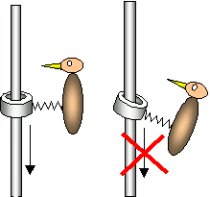
The Woodpecker

The woodpecker toy exemplifies again the law of conservation of energy. Descending down a stick and pecking hard with its beak he converts his potential energy into maintaining the swinging motion.

When you tilt the woodpecker back, the spring stretches, and after releasing, sets the woodpecker into swinging motion. Each time the ring is aligned with the stick the woodpecker slides down the stick and swings continuously. The inertia of the woodpecker stretches the spring into the opposite direction and the whole cycle gets repeated until the woodpecker reaches the base of the stick.
The initial potential energy possessed by the toy because of its high position is consumed gradually - changing cyclically into kinetic energy of the woodpecker and potential energy of the spring. In conclusion, as a result of friction between the ring and the stick, the initial potential energy is converted into heat.
|
JW Player goes here
|
Why is this motion steady, in spite of the fact that the woodpecker is, in fact, falling down?
Here we deal with dynamic loss of energy. In each cycle the additional kinetic energy of the woodpecker is obtained from its potential energy. Than, this kinetic energy is converted into work against the forces of friction (of the ring against the stick, twitch of the spring, oscillation of the base) i.e. into heat.
What is more, with its weight evenly distributed the woodpecker, has its characteristic pace of descend. In a single cycle, the faster the woodpecker 'slides down' the greater the jerk of the spring; the greater the swing both ways and the pressure force acting on the ring sliding down. The friction increases and as a result the pace of descend gets slower.
Obviously, a defective woodpecker or one which has not been set into swinging motion will simply fall down the stick without pecking.